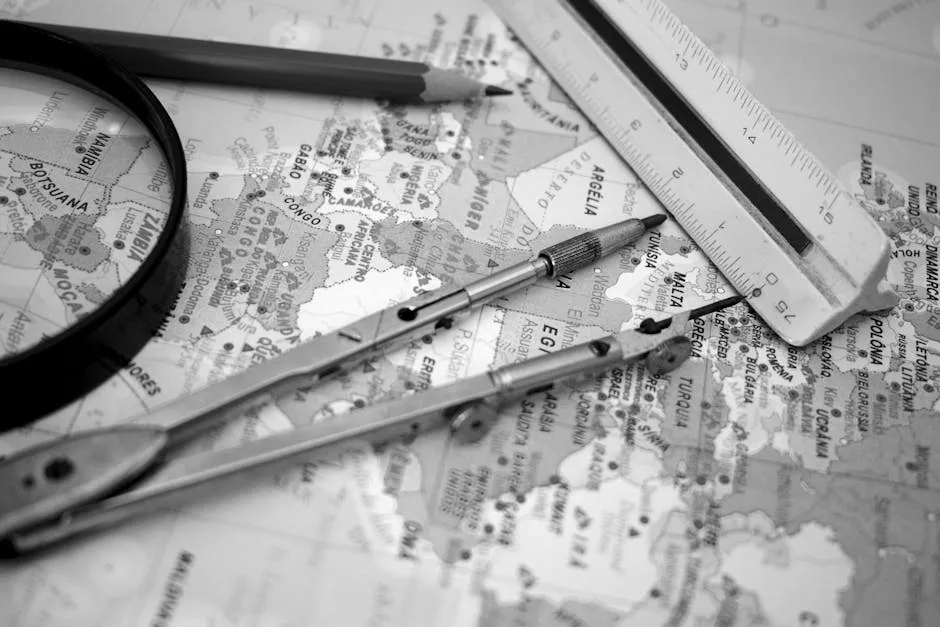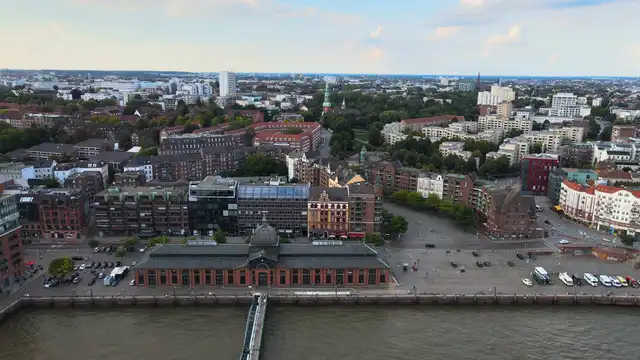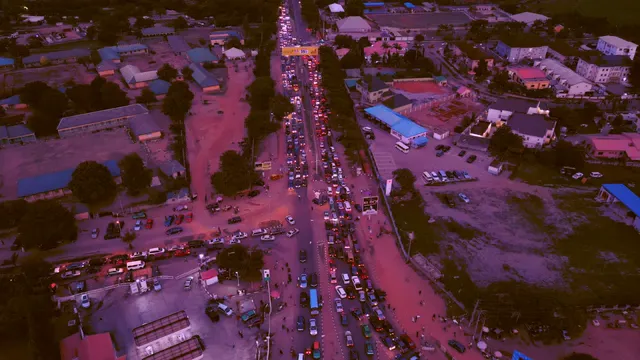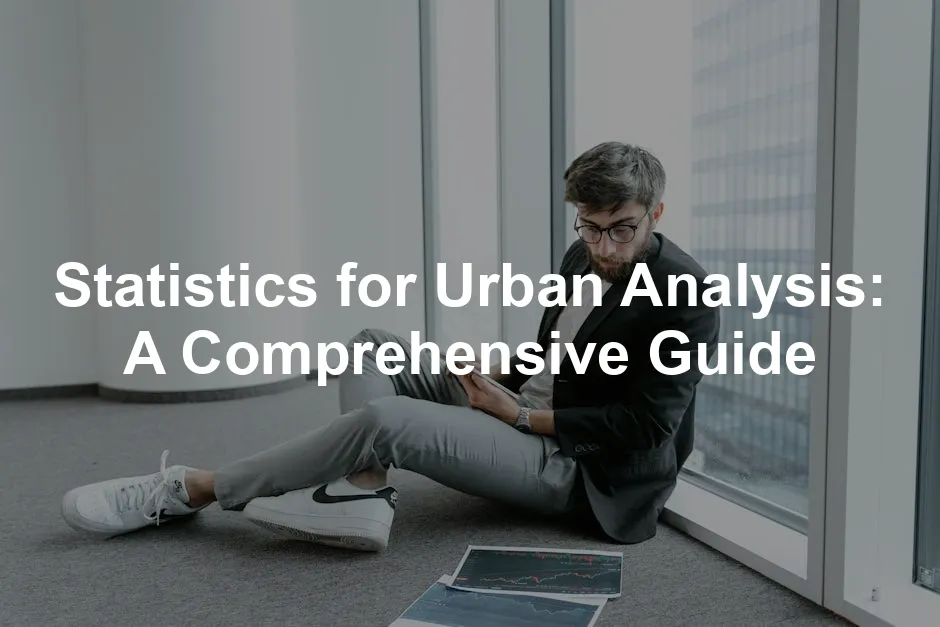- Hypothesis Testing: This technique checks assumptions about urban data. For instance, is there a significant difference in average income between neighborhoods? Analysts set a hypothesis and use sample data to test its validity, helping to answer pressing urban questions.
- Confidence Intervals: These intervals provide a range within which the true population parameter is likely to fall. Say planners estimate the average commute time in a city; a confidence interval might suggest it falls between 25 and 30 minutes. This helps in planning transportation networks.
- Regression Analysis (Simple and Multiple): Regression analysis helps understand relationships between variables. Simple regression looks at one dependent and one independent variable, like how income affects housing prices. Multiple regression considers several factors simultaneously, such as income, education, and location. This gives a clearer picture of urban dynamics.
Inferential statistics are crucial for making urban predictions based on sample data. Explore this further here.
Spatial Statistics
Overview: Spatial statistics is the superhero of urban analysis! It focuses on data with a geographical component, crucial for understanding how location influences urban dynamics. This branch is vital for urban planners who must consider not just what people need, but where those needs should be addressed. Think of it as the GPS for urban development. Techniques:- Geographic Information Systems (GIS): GIS is a powerful tool that allows urban analysts to visualize and analyze spatial data. It helps in mapping crime hotspots or identifying areas lacking green spaces. This way, planners can make informed decisions on where to allocate resources. Don’t forget to check out ArcGIS Software for advanced mapping capabilities!
- Spatial Regression and Modeling: This technique extends traditional regression to account for spatial relationships. If one neighborhood experiences a rise in housing prices, nearby neighborhoods might follow suit. Understanding these patterns helps in predicting future urban growth.
- Hotspot Analysis: This method identifies areas with high concentrations of particular phenomena, like crime or poverty. By spotting these hotspots, city officials can target interventions effectively. For instance, if a neighborhood shows a spike in crime, resources can be diverted there for community programs.

Tools and Software for Data Analysis
Urban analysis relies heavily on tools and software that facilitate data analysis, visualization, and interpretation. These tools help urban planners make sense of complex datasets. Let’s take a closer look at some of the key statistical software and data sources that are essential for effective urban analysis.Statistical Software
STATA: STATA stands out as a popular tool for urban data analysis. With its user-friendly interface, STATA allows for comprehensive statistical analysis, making it easy to interpret urban datasets. Researchers love its versatility, whether they’re running regression models or performing time-series analysis. This software has become an industry standard, particularly for those focusing on social sciences and urban studies. Its extensive documentation and active user community provide ample support for newcomers. Check it out here: STATA Software! R and Python: R and Python have gained traction as go-to programming languages for statistical analyses and data visualization. Both languages offer a wealth of libraries that extend their capabilities. In R,ggplot2 is a favorite for creating stunning visualizations, enabling analysts to present complex data in an engaging manner. On the other hand, Python’s Pandas library excels in data manipulation, making it easier to handle large datasets efficiently. These languages not only allow for advanced statistical techniques but also empower users to create reproducible research processes. If you’re looking to dive into R, consider getting a R Programming Language book to get started!
GIS Software:
Geographic Information Systems (GIS) software like ArcGIS and QGIS are indispensable for spatial analysis. These tools enable urban analysts to visualize demographic data, map infrastructure, and analyze land use patterns. ArcGIS offers a robust suite of tools for data manipulation and visualization, catering to large-scale urban projects. Meanwhile, QGIS, being open-source, provides a cost-effective alternative without sacrificing functionality. Analysts can layer different datasets, perform spatial queries, and generate maps that inform urban planning decisions. Don’t miss out on exploring QGIS Software for a free yet powerful GIS solution!

Data Sources
Public Data Portals: A multitude of public data sources exists for urban statistics. One of the most valuable resources is census data, which provides insights into population demographics, housing, and economic conditions. Local government databases often include information on public services, infrastructure, and urban development projects. Non-profit organizations also contribute valuable datasets, focusing on social issues and community needs. Websites like Data.gov and local open data portals allow urban analysts to access and download relevant datasets for their projects. International Data Sources: When it comes to international urban statistics, organizations like the World Bank and UN-Habitat are go-to sources. The World Bank provides comprehensive datasets on urbanization trends, economic indicators, and social development across nations. UN-Habitat focuses on sustainable urban development, offering reports and datasets that highlight global urban challenges. This international perspective is crucial for urban planners aiming to create solutions that are not only locally relevant but also globally informed. By leveraging these tools and data sources, urban analysts can effectively tackle complex urban challenges, ultimately leading to smarter city planning and improved quality of life for residents. The combination of robust statistical software and comprehensive data sources forms the backbone of effective urban analysis, enabling planners to make informed, data-driven decisions.
Case Studies
Successful Applications of Statistics in Urban Analysis
Case Study 1: Urban Renewal in Detroit Once a symbol of industrial decline, Detroit has made strides in urban renewal through statistical analysis. The city launched a revitalization plan focusing on neighborhoods hit hardest by economic downturns. Using data from the U.S. Census Bureau, analysts identified areas with population declines and high vacancy rates. They then employed regression models to understand the relationship between housing prices and neighborhood amenities. As a result, planners targeted investments in parks, public transport, and community services. This data-driven approach led to a 20% increase in property values in revitalized neighborhoods. Today, Detroit is a beacon for urban renewal, showcasing how data can breathe life into struggling communities. Case Study 2: Transportation Infrastructure in Los Angeles Los Angeles is renowned for its traffic woes, but recent data-driven initiatives are turning the tide. The city adopted a comprehensive transportation plan that utilized real-time traffic data and predictive analytics. By analyzing traffic patterns using GIS, planners identified congestion hotspots and optimized traffic light timings. They also used machine learning algorithms to predict future traffic flows based on demographic trends. The result? A significant reduction in commute times by up to 15%. This transformation illustrates how leveraging data can enhance urban mobility, making LA more navigable and less stressful for commuters. Explore more about smart transportation solutions in the Smart Transportation Solutions Book. Case Study 3: Social Justice in Chicago In Chicago, statistics play a pivotal role in promoting social justice and community engagement. The city implemented an initiative called the “Data-Driven Justice” program, which uses data to address systemic inequalities. By analyzing crime data, socioeconomic factors, and community demographics, officials developed targeted policing strategies. They employed spatial analysis to identify crime hotspots and allocate resources effectively. This initiative also included community feedback mechanisms, allowing residents to voice their concerns. As a result, Chicago saw a 30% decrease in crime rates in targeted areas, fostering a sense of safety and trust within communities. This case highlights how statistical analysis can empower citizens and promote equity in urban environments.
Future Trends in Urban Analysis
Big Data and Urban Analytics
The future of urban analysis lies in big data. As cities grow, so does the amount of data generated. This shift allows urban planners to harness vast datasets for better decision-making. From traffic patterns to housing trends, big data analytics enhances our understanding of urban dynamics. Moreover, the integration of AI and machine learning offers unprecedented capabilities. These technologies can identify patterns and predict trends, enabling city officials to make proactive decisions. For instance, predictive analytics can forecast housing demands based on demographic shifts, ensuring that cities are prepared for future growth. As urban analytics continues to evolve, cities will become smarter, more efficient, and better equipped to tackle complex challenges. For insightful strategies on predictive analytics, consider reading the Predictive Analytics Book.
Citizen Science and Participatory Data Collection
Citizen engagement is transforming urban analysis. More than ever, communities are actively participating in data collection, empowering locals to take charge of their urban environments. Initiatives like community mapping allow residents to contribute data on issues like public safety and resource availability. This grassroots approach not only enhances data accuracy but also fosters a sense of ownership. When citizens have a stake in data collection, they are more likely to advocate for changes that reflect their needs. Furthermore, participatory data collection encourages transparency, building trust between communities and local governments. As urban analysis embraces citizen science, it will lead to more inclusive, responsive planning processes that truly reflect the voices of the people. Explore useful tools for community mapping like the Community Mapping Tools.
Conclusion
Statistics serve as the backbone of effective urban analysis. They guide planning decisions, inform resource allocation, and enhance community engagement. The case studies discussed illustrate the transformative power of data in urban renewal, transportation planning, and social justice. As cities face increasing challenges, leveraging statistical methods is crucial for fostering data-driven decision-making. Urban planners, policymakers, and researchers must embrace these tools to create sustainable, equitable, and thriving urban environments. The future of urban analysis looks bright, with data at the helm steering cities toward better living conditions for all. For those interested in further reading, consider delving into the Data-Driven Decision Making Book to empower your understanding.
FAQs
What is urban analysis?
Urban analysis is the study of various factors that influence urban environments. It examines social, economic, and environmental processes to understand how they shape cities.
How do statistics help in urban planning?
Statistics provide insights into demographic trends, housing demands, and resource allocation. By analyzing data, planners can make informed decisions that benefit communities.
What tools are commonly used for urban data analysis?
Popular tools include statistical software like STATA and R, as well as GIS software for spatial analysis. These tools enable analysts to interpret and visualize data effectively.
How is spatial analysis different from traditional statistics?
Spatial analysis focuses on geographic data, considering the location and distribution of phenomena. Traditional statistics generally analyze data without geographic context, missing crucial spatial relationships.
Please let us know what you think about our content by leaving a comment down below!
Thank you for reading till here 🙂
All images from Pexels
Examples: Let’s take a look at how these metrics can be applied:- Population Demographics: Analyzing the mean age and income of residents helps city planners tailor services, like recreational facilities or community programs. For instance, a city with a median age of 25 may prioritize parks and nightlife.
- Housing Trends: When examining housing prices, the median price offers a more accurate depiction than the mean, especially in markets with extreme highs and lows. For instance, if the mean house price is significantly higher than the median, it suggests a few very expensive homes are skewing the average.
- Transportation Analysis: Standard deviation can indicate how consistent public transport is. A low standard deviation in commute times might suggest reliable services, while a high one could signal delays and inefficiencies that need addressing.

Inferential Statistics
Overview: Inferential statistics are the magic wand for urban analysts. They help make predictions or generalizations about urban populations using sample data. Ever wondered how city planners know where to build a new park or school? They rely on these statistics! By analyzing smaller groups, they draw conclusions about the entire city. It’s like guessing the flavor of a cake by tasting just a crumb. Techniques:- Hypothesis Testing: This technique checks assumptions about urban data. For instance, is there a significant difference in average income between neighborhoods? Analysts set a hypothesis and use sample data to test its validity, helping to answer pressing urban questions.
- Confidence Intervals: These intervals provide a range within which the true population parameter is likely to fall. Say planners estimate the average commute time in a city; a confidence interval might suggest it falls between 25 and 30 minutes. This helps in planning transportation networks.
- Regression Analysis (Simple and Multiple): Regression analysis helps understand relationships between variables. Simple regression looks at one dependent and one independent variable, like how income affects housing prices. Multiple regression considers several factors simultaneously, such as income, education, and location. This gives a clearer picture of urban dynamics.
Inferential statistics are crucial for making urban predictions based on sample data. Explore this further here.
Spatial Statistics
Overview: Spatial statistics is the superhero of urban analysis! It focuses on data with a geographical component, crucial for understanding how location influences urban dynamics. This branch is vital for urban planners who must consider not just what people need, but where those needs should be addressed. Think of it as the GPS for urban development. Techniques:- Geographic Information Systems (GIS): GIS is a powerful tool that allows urban analysts to visualize and analyze spatial data. It helps in mapping crime hotspots or identifying areas lacking green spaces. This way, planners can make informed decisions on where to allocate resources. Don’t forget to check out ArcGIS Software for advanced mapping capabilities!
- Spatial Regression and Modeling: This technique extends traditional regression to account for spatial relationships. If one neighborhood experiences a rise in housing prices, nearby neighborhoods might follow suit. Understanding these patterns helps in predicting future urban growth.
- Hotspot Analysis: This method identifies areas with high concentrations of particular phenomena, like crime or poverty. By spotting these hotspots, city officials can target interventions effectively. For instance, if a neighborhood shows a spike in crime, resources can be diverted there for community programs.

Tools and Software for Data Analysis
Urban analysis relies heavily on tools and software that facilitate data analysis, visualization, and interpretation. These tools help urban planners make sense of complex datasets. Let’s take a closer look at some of the key statistical software and data sources that are essential for effective urban analysis.Statistical Software
STATA: STATA stands out as a popular tool for urban data analysis. With its user-friendly interface, STATA allows for comprehensive statistical analysis, making it easy to interpret urban datasets. Researchers love its versatility, whether they’re running regression models or performing time-series analysis. This software has become an industry standard, particularly for those focusing on social sciences and urban studies. Its extensive documentation and active user community provide ample support for newcomers. Check it out here: STATA Software! R and Python: R and Python have gained traction as go-to programming languages for statistical analyses and data visualization. Both languages offer a wealth of libraries that extend their capabilities. In R,ggplot2 is a favorite for creating stunning visualizations, enabling analysts to present complex data in an engaging manner. On the other hand, Python’s Pandas library excels in data manipulation, making it easier to handle large datasets efficiently. These languages not only allow for advanced statistical techniques but also empower users to create reproducible research processes. If you’re looking to dive into R, consider getting a R Programming Language book to get started!
GIS Software:
Geographic Information Systems (GIS) software like ArcGIS and QGIS are indispensable for spatial analysis. These tools enable urban analysts to visualize demographic data, map infrastructure, and analyze land use patterns. ArcGIS offers a robust suite of tools for data manipulation and visualization, catering to large-scale urban projects. Meanwhile, QGIS, being open-source, provides a cost-effective alternative without sacrificing functionality. Analysts can layer different datasets, perform spatial queries, and generate maps that inform urban planning decisions. Don’t miss out on exploring QGIS Software for a free yet powerful GIS solution!

Data Sources
Public Data Portals: A multitude of public data sources exists for urban statistics. One of the most valuable resources is census data, which provides insights into population demographics, housing, and economic conditions. Local government databases often include information on public services, infrastructure, and urban development projects. Non-profit organizations also contribute valuable datasets, focusing on social issues and community needs. Websites like Data.gov and local open data portals allow urban analysts to access and download relevant datasets for their projects. International Data Sources: When it comes to international urban statistics, organizations like the World Bank and UN-Habitat are go-to sources. The World Bank provides comprehensive datasets on urbanization trends, economic indicators, and social development across nations. UN-Habitat focuses on sustainable urban development, offering reports and datasets that highlight global urban challenges. This international perspective is crucial for urban planners aiming to create solutions that are not only locally relevant but also globally informed. By leveraging these tools and data sources, urban analysts can effectively tackle complex urban challenges, ultimately leading to smarter city planning and improved quality of life for residents. The combination of robust statistical software and comprehensive data sources forms the backbone of effective urban analysis, enabling planners to make informed, data-driven decisions.
Case Studies
Successful Applications of Statistics in Urban Analysis
Case Study 1: Urban Renewal in Detroit Once a symbol of industrial decline, Detroit has made strides in urban renewal through statistical analysis. The city launched a revitalization plan focusing on neighborhoods hit hardest by economic downturns. Using data from the U.S. Census Bureau, analysts identified areas with population declines and high vacancy rates. They then employed regression models to understand the relationship between housing prices and neighborhood amenities. As a result, planners targeted investments in parks, public transport, and community services. This data-driven approach led to a 20% increase in property values in revitalized neighborhoods. Today, Detroit is a beacon for urban renewal, showcasing how data can breathe life into struggling communities. Case Study 2: Transportation Infrastructure in Los Angeles Los Angeles is renowned for its traffic woes, but recent data-driven initiatives are turning the tide. The city adopted a comprehensive transportation plan that utilized real-time traffic data and predictive analytics. By analyzing traffic patterns using GIS, planners identified congestion hotspots and optimized traffic light timings. They also used machine learning algorithms to predict future traffic flows based on demographic trends. The result? A significant reduction in commute times by up to 15%. This transformation illustrates how leveraging data can enhance urban mobility, making LA more navigable and less stressful for commuters. Explore more about smart transportation solutions in the Smart Transportation Solutions Book. Case Study 3: Social Justice in Chicago In Chicago, statistics play a pivotal role in promoting social justice and community engagement. The city implemented an initiative called the “Data-Driven Justice” program, which uses data to address systemic inequalities. By analyzing crime data, socioeconomic factors, and community demographics, officials developed targeted policing strategies. They employed spatial analysis to identify crime hotspots and allocate resources effectively. This initiative also included community feedback mechanisms, allowing residents to voice their concerns. As a result, Chicago saw a 30% decrease in crime rates in targeted areas, fostering a sense of safety and trust within communities. This case highlights how statistical analysis can empower citizens and promote equity in urban environments.
Future Trends in Urban Analysis
Big Data and Urban Analytics
The future of urban analysis lies in big data. As cities grow, so does the amount of data generated. This shift allows urban planners to harness vast datasets for better decision-making. From traffic patterns to housing trends, big data analytics enhances our understanding of urban dynamics. Moreover, the integration of AI and machine learning offers unprecedented capabilities. These technologies can identify patterns and predict trends, enabling city officials to make proactive decisions. For instance, predictive analytics can forecast housing demands based on demographic shifts, ensuring that cities are prepared for future growth. As urban analytics continues to evolve, cities will become smarter, more efficient, and better equipped to tackle complex challenges. For insightful strategies on predictive analytics, consider reading the Predictive Analytics Book.
Citizen Science and Participatory Data Collection
Citizen engagement is transforming urban analysis. More than ever, communities are actively participating in data collection, empowering locals to take charge of their urban environments. Initiatives like community mapping allow residents to contribute data on issues like public safety and resource availability. This grassroots approach not only enhances data accuracy but also fosters a sense of ownership. When citizens have a stake in data collection, they are more likely to advocate for changes that reflect their needs. Furthermore, participatory data collection encourages transparency, building trust between communities and local governments. As urban analysis embraces citizen science, it will lead to more inclusive, responsive planning processes that truly reflect the voices of the people. Explore useful tools for community mapping like the Community Mapping Tools.
Conclusion
Statistics serve as the backbone of effective urban analysis. They guide planning decisions, inform resource allocation, and enhance community engagement. The case studies discussed illustrate the transformative power of data in urban renewal, transportation planning, and social justice. As cities face increasing challenges, leveraging statistical methods is crucial for fostering data-driven decision-making. Urban planners, policymakers, and researchers must embrace these tools to create sustainable, equitable, and thriving urban environments. The future of urban analysis looks bright, with data at the helm steering cities toward better living conditions for all. For those interested in further reading, consider delving into the Data-Driven Decision Making Book to empower your understanding.
FAQs
Please let us know what you think about our content by leaving a comment down below!
Thank you for reading till here 🙂
All images from Pexels
Key Metrics: Several key metrics are essential in this realm:- Mean: The average value. It helps in understanding typical household incomes or average commute times in a city.
- Median: The middle value when data is sorted. It’s particularly useful in housing data, as it indicates the midpoint of home prices, avoiding skewed results from outliers.
- Mode: The most frequently occurring value. This metric can reveal the most common types of housing units or transportation methods used by residents.
- Standard Deviation: This measures the variability of data. It’s vital for assessing income disparity or the range of public transportation times across different neighborhoods.
- Population Demographics: Analyzing the mean age and income of residents helps city planners tailor services, like recreational facilities or community programs. For instance, a city with a median age of 25 may prioritize parks and nightlife.
- Housing Trends: When examining housing prices, the median price offers a more accurate depiction than the mean, especially in markets with extreme highs and lows. For instance, if the mean house price is significantly higher than the median, it suggests a few very expensive homes are skewing the average.
- Transportation Analysis: Standard deviation can indicate how consistent public transport is. A low standard deviation in commute times might suggest reliable services, while a high one could signal delays and inefficiencies that need addressing.

Inferential Statistics
Overview: Inferential statistics are the magic wand for urban analysts. They help make predictions or generalizations about urban populations using sample data. Ever wondered how city planners know where to build a new park or school? They rely on these statistics! By analyzing smaller groups, they draw conclusions about the entire city. It’s like guessing the flavor of a cake by tasting just a crumb. Techniques:- Hypothesis Testing: This technique checks assumptions about urban data. For instance, is there a significant difference in average income between neighborhoods? Analysts set a hypothesis and use sample data to test its validity, helping to answer pressing urban questions.
- Confidence Intervals: These intervals provide a range within which the true population parameter is likely to fall. Say planners estimate the average commute time in a city; a confidence interval might suggest it falls between 25 and 30 minutes. This helps in planning transportation networks.
- Regression Analysis (Simple and Multiple): Regression analysis helps understand relationships between variables. Simple regression looks at one dependent and one independent variable, like how income affects housing prices. Multiple regression considers several factors simultaneously, such as income, education, and location. This gives a clearer picture of urban dynamics.
Inferential statistics are crucial for making urban predictions based on sample data. Explore this further here.
Spatial Statistics
Overview: Spatial statistics is the superhero of urban analysis! It focuses on data with a geographical component, crucial for understanding how location influences urban dynamics. This branch is vital for urban planners who must consider not just what people need, but where those needs should be addressed. Think of it as the GPS for urban development. Techniques:- Geographic Information Systems (GIS): GIS is a powerful tool that allows urban analysts to visualize and analyze spatial data. It helps in mapping crime hotspots or identifying areas lacking green spaces. This way, planners can make informed decisions on where to allocate resources. Don’t forget to check out ArcGIS Software for advanced mapping capabilities!
- Spatial Regression and Modeling: This technique extends traditional regression to account for spatial relationships. If one neighborhood experiences a rise in housing prices, nearby neighborhoods might follow suit. Understanding these patterns helps in predicting future urban growth.
- Hotspot Analysis: This method identifies areas with high concentrations of particular phenomena, like crime or poverty. By spotting these hotspots, city officials can target interventions effectively. For instance, if a neighborhood shows a spike in crime, resources can be diverted there for community programs.

Tools and Software for Data Analysis
Urban analysis relies heavily on tools and software that facilitate data analysis, visualization, and interpretation. These tools help urban planners make sense of complex datasets. Let’s take a closer look at some of the key statistical software and data sources that are essential for effective urban analysis.Statistical Software
STATA: STATA stands out as a popular tool for urban data analysis. With its user-friendly interface, STATA allows for comprehensive statistical analysis, making it easy to interpret urban datasets. Researchers love its versatility, whether they’re running regression models or performing time-series analysis. This software has become an industry standard, particularly for those focusing on social sciences and urban studies. Its extensive documentation and active user community provide ample support for newcomers. Check it out here: STATA Software! R and Python: R and Python have gained traction as go-to programming languages for statistical analyses and data visualization. Both languages offer a wealth of libraries that extend their capabilities. In R,ggplot2 is a favorite for creating stunning visualizations, enabling analysts to present complex data in an engaging manner. On the other hand, Python’s Pandas library excels in data manipulation, making it easier to handle large datasets efficiently. These languages not only allow for advanced statistical techniques but also empower users to create reproducible research processes. If you’re looking to dive into R, consider getting a R Programming Language book to get started!
GIS Software:
Geographic Information Systems (GIS) software like ArcGIS and QGIS are indispensable for spatial analysis. These tools enable urban analysts to visualize demographic data, map infrastructure, and analyze land use patterns. ArcGIS offers a robust suite of tools for data manipulation and visualization, catering to large-scale urban projects. Meanwhile, QGIS, being open-source, provides a cost-effective alternative without sacrificing functionality. Analysts can layer different datasets, perform spatial queries, and generate maps that inform urban planning decisions. Don’t miss out on exploring QGIS Software for a free yet powerful GIS solution!

Data Sources
Public Data Portals: A multitude of public data sources exists for urban statistics. One of the most valuable resources is census data, which provides insights into population demographics, housing, and economic conditions. Local government databases often include information on public services, infrastructure, and urban development projects. Non-profit organizations also contribute valuable datasets, focusing on social issues and community needs. Websites like Data.gov and local open data portals allow urban analysts to access and download relevant datasets for their projects. International Data Sources: When it comes to international urban statistics, organizations like the World Bank and UN-Habitat are go-to sources. The World Bank provides comprehensive datasets on urbanization trends, economic indicators, and social development across nations. UN-Habitat focuses on sustainable urban development, offering reports and datasets that highlight global urban challenges. This international perspective is crucial for urban planners aiming to create solutions that are not only locally relevant but also globally informed. By leveraging these tools and data sources, urban analysts can effectively tackle complex urban challenges, ultimately leading to smarter city planning and improved quality of life for residents. The combination of robust statistical software and comprehensive data sources forms the backbone of effective urban analysis, enabling planners to make informed, data-driven decisions.
Case Studies
Successful Applications of Statistics in Urban Analysis
Case Study 1: Urban Renewal in Detroit Once a symbol of industrial decline, Detroit has made strides in urban renewal through statistical analysis. The city launched a revitalization plan focusing on neighborhoods hit hardest by economic downturns. Using data from the U.S. Census Bureau, analysts identified areas with population declines and high vacancy rates. They then employed regression models to understand the relationship between housing prices and neighborhood amenities. As a result, planners targeted investments in parks, public transport, and community services. This data-driven approach led to a 20% increase in property values in revitalized neighborhoods. Today, Detroit is a beacon for urban renewal, showcasing how data can breathe life into struggling communities. Case Study 2: Transportation Infrastructure in Los Angeles Los Angeles is renowned for its traffic woes, but recent data-driven initiatives are turning the tide. The city adopted a comprehensive transportation plan that utilized real-time traffic data and predictive analytics. By analyzing traffic patterns using GIS, planners identified congestion hotspots and optimized traffic light timings. They also used machine learning algorithms to predict future traffic flows based on demographic trends. The result? A significant reduction in commute times by up to 15%. This transformation illustrates how leveraging data can enhance urban mobility, making LA more navigable and less stressful for commuters. Explore more about smart transportation solutions in the Smart Transportation Solutions Book. Case Study 3: Social Justice in Chicago In Chicago, statistics play a pivotal role in promoting social justice and community engagement. The city implemented an initiative called the “Data-Driven Justice” program, which uses data to address systemic inequalities. By analyzing crime data, socioeconomic factors, and community demographics, officials developed targeted policing strategies. They employed spatial analysis to identify crime hotspots and allocate resources effectively. This initiative also included community feedback mechanisms, allowing residents to voice their concerns. As a result, Chicago saw a 30% decrease in crime rates in targeted areas, fostering a sense of safety and trust within communities. This case highlights how statistical analysis can empower citizens and promote equity in urban environments.
Future Trends in Urban Analysis
Big Data and Urban Analytics
The future of urban analysis lies in big data. As cities grow, so does the amount of data generated. This shift allows urban planners to harness vast datasets for better decision-making. From traffic patterns to housing trends, big data analytics enhances our understanding of urban dynamics. Moreover, the integration of AI and machine learning offers unprecedented capabilities. These technologies can identify patterns and predict trends, enabling city officials to make proactive decisions. For instance, predictive analytics can forecast housing demands based on demographic shifts, ensuring that cities are prepared for future growth. As urban analytics continues to evolve, cities will become smarter, more efficient, and better equipped to tackle complex challenges. For insightful strategies on predictive analytics, consider reading the Predictive Analytics Book.
Citizen Science and Participatory Data Collection
Citizen engagement is transforming urban analysis. More than ever, communities are actively participating in data collection, empowering locals to take charge of their urban environments. Initiatives like community mapping allow residents to contribute data on issues like public safety and resource availability. This grassroots approach not only enhances data accuracy but also fosters a sense of ownership. When citizens have a stake in data collection, they are more likely to advocate for changes that reflect their needs. Furthermore, participatory data collection encourages transparency, building trust between communities and local governments. As urban analysis embraces citizen science, it will lead to more inclusive, responsive planning processes that truly reflect the voices of the people. Explore useful tools for community mapping like the Community Mapping Tools.
Conclusion
Statistics serve as the backbone of effective urban analysis. They guide planning decisions, inform resource allocation, and enhance community engagement. The case studies discussed illustrate the transformative power of data in urban renewal, transportation planning, and social justice. As cities face increasing challenges, leveraging statistical methods is crucial for fostering data-driven decision-making. Urban planners, policymakers, and researchers must embrace these tools to create sustainable, equitable, and thriving urban environments. The future of urban analysis looks bright, with data at the helm steering cities toward better living conditions for all. For those interested in further reading, consider delving into the Data-Driven Decision Making Book to empower your understanding.
FAQs
Please let us know what you think about our content by leaving a comment down below!
Thank you for reading till here 🙂
All images from Pexels
Introduction
Urban analysis is the secret sauce for effective city planning. It examines the complex web of factors that shape urban areas. With more than half of the world’s population living in cities, understanding urban dynamics is crucial. Statistics play a vital role, offering insights into demographic trends, infrastructure needs, and social issues. Without data, urban planners are like chefs without a recipe—lost in a sea of ingredients! Statistics allow us to decode urban life. They help in assessing population growth, migration patterns, and housing demands. As cities evolve, so do their challenges. From traffic congestion to housing shortages, statistics guide policymakers in making informed decisions. This data-driven approach enhances resource allocation, ensuring that every dollar spent helps improve city life. Moreover, robust statistical data fosters community engagement. When citizens see data-backed decisions, trust in local government grows. A well-informed populace can voice their needs more effectively. This synergy between data and community ensures that urban development benefits everyone. The purpose of this article is to provide an extensive overview of the statistical methods and tools used in urban analysis. We’ll explore how to harness data to tackle urban challenges and enhance city living. So, buckle up as we embark on this enlightening journey through urban statistics!
Understanding Urban Analysis
Urban analysis is a multidisciplinary approach to understanding urban environments. At its core, it examines how various factors—social, economic, and environmental—interact within cities. This exploration is essential for effective urban planning and policymaking. The relevance of urban analysis spans multiple fields. Geography provides insights into spatial relationships, while sociology helps decode community dynamics. Economics shines a light on market forces shaping urban growth. Environmental studies highlight sustainability challenges that cities face. Together, these disciplines create a holistic framework for understanding urban spaces. Urban analysis is not just a theoretical exercise; it’s a practical necessity. Cities are increasingly grappling with issues like urban sprawl, transportation woes, and social inequalities. By applying statistical methods, urban analysts can identify trends and patterns essential for strategic planning. For instance, analyzing crime data can lead to safer neighborhoods. Similarly, studying housing trends helps in addressing affordability crises. This interdisciplinary nature fosters collaboration among urban planners, statisticians, and community advocates. The synergy of their expertise drives innovative solutions to urban problems. Ultimately, understanding urban analysis equips stakeholders with the tools to create vibrant, sustainable, and equitable cities. As we navigate this complex terrain, statistical insights will pave the way for smarter urban futures.
Statistical Techniques in Urban Analysis
Descriptive Statistics
Overview: Descriptive statistics play a crucial role in urban analysis. They summarize vast amounts of urban data into digestible insights. Think of it as a quick snapshot of the city—what’s happening, who’s living there, and how things are changing. This method helps urban planners identify patterns and trends without getting lost in the numbers. For a comprehensive guide on this topic, check out descriptive statistics in manufacturing plant.Key Metrics: Several key metrics are essential in this realm:Descriptive statistics are essential for summarizing urban data effectively. Learn more about this topic here.
- Mean: The average value. It helps in understanding typical household incomes or average commute times in a city.
- Median: The middle value when data is sorted. It’s particularly useful in housing data, as it indicates the midpoint of home prices, avoiding skewed results from outliers.
- Mode: The most frequently occurring value. This metric can reveal the most common types of housing units or transportation methods used by residents.
- Standard Deviation: This measures the variability of data. It’s vital for assessing income disparity or the range of public transportation times across different neighborhoods.
- Population Demographics: Analyzing the mean age and income of residents helps city planners tailor services, like recreational facilities or community programs. For instance, a city with a median age of 25 may prioritize parks and nightlife.
- Housing Trends: When examining housing prices, the median price offers a more accurate depiction than the mean, especially in markets with extreme highs and lows. For instance, if the mean house price is significantly higher than the median, it suggests a few very expensive homes are skewing the average.
- Transportation Analysis: Standard deviation can indicate how consistent public transport is. A low standard deviation in commute times might suggest reliable services, while a high one could signal delays and inefficiencies that need addressing.

Inferential Statistics
Overview: Inferential statistics are the magic wand for urban analysts. They help make predictions or generalizations about urban populations using sample data. Ever wondered how city planners know where to build a new park or school? They rely on these statistics! By analyzing smaller groups, they draw conclusions about the entire city. It’s like guessing the flavor of a cake by tasting just a crumb. Techniques:- Hypothesis Testing: This technique checks assumptions about urban data. For instance, is there a significant difference in average income between neighborhoods? Analysts set a hypothesis and use sample data to test its validity, helping to answer pressing urban questions.
- Confidence Intervals: These intervals provide a range within which the true population parameter is likely to fall. Say planners estimate the average commute time in a city; a confidence interval might suggest it falls between 25 and 30 minutes. This helps in planning transportation networks.
- Regression Analysis (Simple and Multiple): Regression analysis helps understand relationships between variables. Simple regression looks at one dependent and one independent variable, like how income affects housing prices. Multiple regression considers several factors simultaneously, such as income, education, and location. This gives a clearer picture of urban dynamics.
Inferential statistics are crucial for making urban predictions based on sample data. Explore this further here.
Spatial Statistics
Overview: Spatial statistics is the superhero of urban analysis! It focuses on data with a geographical component, crucial for understanding how location influences urban dynamics. This branch is vital for urban planners who must consider not just what people need, but where those needs should be addressed. Think of it as the GPS for urban development. Techniques:- Geographic Information Systems (GIS): GIS is a powerful tool that allows urban analysts to visualize and analyze spatial data. It helps in mapping crime hotspots or identifying areas lacking green spaces. This way, planners can make informed decisions on where to allocate resources. Don’t forget to check out ArcGIS Software for advanced mapping capabilities!
- Spatial Regression and Modeling: This technique extends traditional regression to account for spatial relationships. If one neighborhood experiences a rise in housing prices, nearby neighborhoods might follow suit. Understanding these patterns helps in predicting future urban growth.
- Hotspot Analysis: This method identifies areas with high concentrations of particular phenomena, like crime or poverty. By spotting these hotspots, city officials can target interventions effectively. For instance, if a neighborhood shows a spike in crime, resources can be diverted there for community programs.

Tools and Software for Data Analysis
Urban analysis relies heavily on tools and software that facilitate data analysis, visualization, and interpretation. These tools help urban planners make sense of complex datasets. Let’s take a closer look at some of the key statistical software and data sources that are essential for effective urban analysis.Statistical Software
STATA: STATA stands out as a popular tool for urban data analysis. With its user-friendly interface, STATA allows for comprehensive statistical analysis, making it easy to interpret urban datasets. Researchers love its versatility, whether they’re running regression models or performing time-series analysis. This software has become an industry standard, particularly for those focusing on social sciences and urban studies. Its extensive documentation and active user community provide ample support for newcomers. Check it out here: STATA Software! R and Python: R and Python have gained traction as go-to programming languages for statistical analyses and data visualization. Both languages offer a wealth of libraries that extend their capabilities. In R,ggplot2 is a favorite for creating stunning visualizations, enabling analysts to present complex data in an engaging manner. On the other hand, Python’s Pandas library excels in data manipulation, making it easier to handle large datasets efficiently. These languages not only allow for advanced statistical techniques but also empower users to create reproducible research processes. If you’re looking to dive into R, consider getting a R Programming Language book to get started!
GIS Software:
Geographic Information Systems (GIS) software like ArcGIS and QGIS are indispensable for spatial analysis. These tools enable urban analysts to visualize demographic data, map infrastructure, and analyze land use patterns. ArcGIS offers a robust suite of tools for data manipulation and visualization, catering to large-scale urban projects. Meanwhile, QGIS, being open-source, provides a cost-effective alternative without sacrificing functionality. Analysts can layer different datasets, perform spatial queries, and generate maps that inform urban planning decisions. Don’t miss out on exploring QGIS Software for a free yet powerful GIS solution!

Data Sources
Public Data Portals: A multitude of public data sources exists for urban statistics. One of the most valuable resources is census data, which provides insights into population demographics, housing, and economic conditions. Local government databases often include information on public services, infrastructure, and urban development projects. Non-profit organizations also contribute valuable datasets, focusing on social issues and community needs. Websites like Data.gov and local open data portals allow urban analysts to access and download relevant datasets for their projects. International Data Sources: When it comes to international urban statistics, organizations like the World Bank and UN-Habitat are go-to sources. The World Bank provides comprehensive datasets on urbanization trends, economic indicators, and social development across nations. UN-Habitat focuses on sustainable urban development, offering reports and datasets that highlight global urban challenges. This international perspective is crucial for urban planners aiming to create solutions that are not only locally relevant but also globally informed. By leveraging these tools and data sources, urban analysts can effectively tackle complex urban challenges, ultimately leading to smarter city planning and improved quality of life for residents. The combination of robust statistical software and comprehensive data sources forms the backbone of effective urban analysis, enabling planners to make informed, data-driven decisions.
Case Studies
Successful Applications of Statistics in Urban Analysis
Case Study 1: Urban Renewal in Detroit Once a symbol of industrial decline, Detroit has made strides in urban renewal through statistical analysis. The city launched a revitalization plan focusing on neighborhoods hit hardest by economic downturns. Using data from the U.S. Census Bureau, analysts identified areas with population declines and high vacancy rates. They then employed regression models to understand the relationship between housing prices and neighborhood amenities. As a result, planners targeted investments in parks, public transport, and community services. This data-driven approach led to a 20% increase in property values in revitalized neighborhoods. Today, Detroit is a beacon for urban renewal, showcasing how data can breathe life into struggling communities. Case Study 2: Transportation Infrastructure in Los Angeles Los Angeles is renowned for its traffic woes, but recent data-driven initiatives are turning the tide. The city adopted a comprehensive transportation plan that utilized real-time traffic data and predictive analytics. By analyzing traffic patterns using GIS, planners identified congestion hotspots and optimized traffic light timings. They also used machine learning algorithms to predict future traffic flows based on demographic trends. The result? A significant reduction in commute times by up to 15%. This transformation illustrates how leveraging data can enhance urban mobility, making LA more navigable and less stressful for commuters. Explore more about smart transportation solutions in the Smart Transportation Solutions Book. Case Study 3: Social Justice in Chicago In Chicago, statistics play a pivotal role in promoting social justice and community engagement. The city implemented an initiative called the “Data-Driven Justice” program, which uses data to address systemic inequalities. By analyzing crime data, socioeconomic factors, and community demographics, officials developed targeted policing strategies. They employed spatial analysis to identify crime hotspots and allocate resources effectively. This initiative also included community feedback mechanisms, allowing residents to voice their concerns. As a result, Chicago saw a 30% decrease in crime rates in targeted areas, fostering a sense of safety and trust within communities. This case highlights how statistical analysis can empower citizens and promote equity in urban environments.
Future Trends in Urban Analysis
Big Data and Urban Analytics
The future of urban analysis lies in big data. As cities grow, so does the amount of data generated. This shift allows urban planners to harness vast datasets for better decision-making. From traffic patterns to housing trends, big data analytics enhances our understanding of urban dynamics. Moreover, the integration of AI and machine learning offers unprecedented capabilities. These technologies can identify patterns and predict trends, enabling city officials to make proactive decisions. For instance, predictive analytics can forecast housing demands based on demographic shifts, ensuring that cities are prepared for future growth. As urban analytics continues to evolve, cities will become smarter, more efficient, and better equipped to tackle complex challenges. For insightful strategies on predictive analytics, consider reading the Predictive Analytics Book.
Citizen Science and Participatory Data Collection
Citizen engagement is transforming urban analysis. More than ever, communities are actively participating in data collection, empowering locals to take charge of their urban environments. Initiatives like community mapping allow residents to contribute data on issues like public safety and resource availability. This grassroots approach not only enhances data accuracy but also fosters a sense of ownership. When citizens have a stake in data collection, they are more likely to advocate for changes that reflect their needs. Furthermore, participatory data collection encourages transparency, building trust between communities and local governments. As urban analysis embraces citizen science, it will lead to more inclusive, responsive planning processes that truly reflect the voices of the people. Explore useful tools for community mapping like the Community Mapping Tools.
Conclusion
Statistics serve as the backbone of effective urban analysis. They guide planning decisions, inform resource allocation, and enhance community engagement. The case studies discussed illustrate the transformative power of data in urban renewal, transportation planning, and social justice. As cities face increasing challenges, leveraging statistical methods is crucial for fostering data-driven decision-making. Urban planners, policymakers, and researchers must embrace these tools to create sustainable, equitable, and thriving urban environments. The future of urban analysis looks bright, with data at the helm steering cities toward better living conditions for all. For those interested in further reading, consider delving into the Data-Driven Decision Making Book to empower your understanding.
FAQs
Please let us know what you think about our content by leaving a comment down below!
Thank you for reading till here 🙂
All images from Pexels




